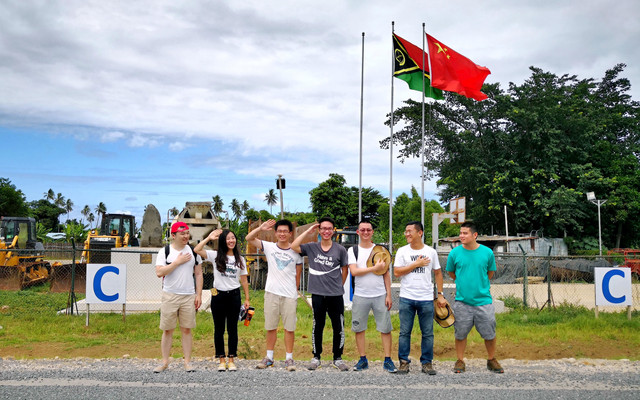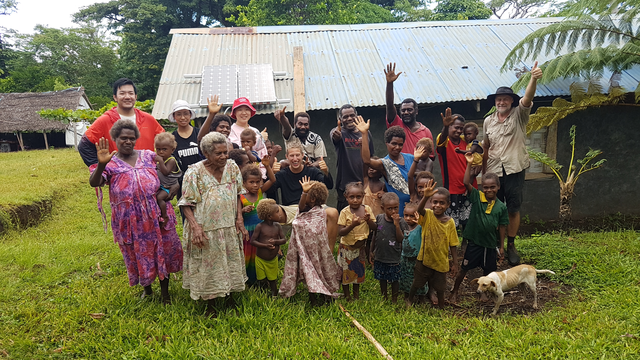
Solar photovoltaic educational project brings lasting benefits to the island of Tanna and the UNSW Engineering students who take part.
Against the odds (never a lack of willingness, often a scarcity of time and funding), a passion project initiated over a decade ago by Dr Richard Corkish to enrich the educational experience of his students continues to go from strength to strength.

The project, called, offers UNSW Photovoltaic and Renewable Energy Engineering (SPREE) students the opportunity to design solar photovoltaic (PV) systems. Then they travel to the island of Tanna, Vanuatu to undertake installations in health posts and schools. The project is currently funded until the end of 2019 by the UNSW Institute of Global Development, but there have been many other generous supporters along the way.
“It all started in 2007/8 with a few eager second-year students visiting Vanuatu to install roof gutters, rainwater tanks and solar lighting,” says Corkish. “Since then we have generated enough funds to send over 35 students to Vanuatu.”
Corkish, a senior lecturer at SPREE, says the project has enabled him to marry his interest in creating unique learning experiences for students, with his interest in humanitarian engineering: specifically, connecting with local villagers on Tanna and students from UNSW and the University of the South Pacific to provide a sustainable source of energy and improve the quality of life of people on the island.
Because services are so scarce in the villages, even simple solar power systems can make an immense difference. UNSWERV usually builds 12VDC systems, avoiding high-voltage and taking advantage of components mass-produced for the global auto market. They normally use good-quality second-hand solar panels donated by a school in Sydney and use efficient LED lights and USB charging supplies for mobile phones.
“Phone-charging facilities are a particularly important part of the island’s emergency and medical services response system. A mobile phone network is the primary way the government can issue warnings of incoming cyclones, for example,” Corkish says.
The installations required a lot of troubleshooting, but the looks on the villagers’ faces when the lights went on is something I’ll never forget.
Dan Liu, UNSW alumna, School of Photovoltaics and Renewable Energy Engineering
Capacity building and skills transfer are a growing component of the UNSWERV project and a key focus for the future. One of the students, Belinda Lam (Bachelor of Renewable Energy Engineering/Bachelor of Marketing) who travelled to Tanna in 2017 took the initiative to create a maintenance and trouble-shooting guide using her experiences before, during and after her trip.
“It has already proven to be a useful resource. I used it to create a PowerPoint presentation for a couple of workshops on batteries, equipment, solar panel positioning and maintenance, which I presented to local communities in Tanna,” Corkish continues.
The information has been compiled into a booklet which Corkish hopes to launch at the Australian High Commission in August this year. Copies will be printed with the help of the Australian Government’s Mission Innovation Program, and it will also be freely available online.
Although it has a deliberate humanitarian focus, Corkish says the primary aim of the project is education. “Students can put their heart and soul into it and apply their knowledge in a highly tangible way. In terms of educational outcomes, this is an excellent way to learn. They work hard to do a great job, they are emotionally involved in the outcome, they learn how to communicate across cultures, and genuinely create positive change.”
SPREE alumna Dan Liu visited Tanna in January 2018 as part of her solar energy engineering Masters Degree. Now graduated, she is working as a solar engineer for a Coffs Harbour solar company. She was interested in the project as soon as she heard about it.
“I wanted to have a meaningful experience overseas and knew if I could solve the challenges I faced, it would improve my problem-solving abilities and bring a sense of achievement, which it certainly did,” she says.
“The installations required a lot of troubleshooting, but the looks on the villagers’ faces when the lights went on is something I’ll never forget.”
Liu says the experience will stay with her for the rest of her life. “It changed me a lot. I have more courage to face the future and it motivates me to improve my professional skills and do more to help disadvantaged people,” she says.
Another group will visit the region in September 2019 to continue installations and Corkish says there will be an additional dimension because he has partnered with Professor Klaus Regenauer-Leib from the School of Minerals and Energy Resources Engineering to explore the potential of using the abundant geothermal energy on the island.
“We’ll be looking at exploiting the geothermal energy from the volcano at the village-scale level,” he says. “We’re hoping this will lead to small-scale electricity production and assist in activities such as food processing and preserving. It’s a really exciting development.”
Can you help?
To find out more about UNSWERV and how you can get involved you can visit their website here or contact Richard Corkish: r.corkish@unsw.edu.au
Huge thanks to our sponsors and supporters
- UNSW Institute for Global Development
- The Darcy and Patricia Wentworth Foundation
- 5B Australia
- Alpha ESS Australia
- St Marys Senior High School
- Alternative Technology Association
- Redlands School
- Timbre Flaws Choir
- SPREE
